It is not as well known as Toledo o Segovia, nor is it a tourist destination as visited as the Escorial monasteryBut city of Avila It is a very interesting visit that you can do in one getaway from Madrid.
Located northwest of the capital, after the Sierra de Guadarrama, Ávila has a powerful argument for visiting it, its imposing and spectacular wall.
But I already tell you that Ávila It is much more than the wall.
It is a small city where you can feel the medieval atmosphere, with its network of streets within the walls, and where they are still preserved 11 Romanesque churches, although there are only three of them within the walled area.
Ávila It is a city that specifically had a great boom during the 16th century, as shown in the up to 30 palaces that are preserved, several of which you can visit, and it is also the city of Saint Teresa of Jesus.
Su gastronomy It is another outstanding attraction to visit, as well as take advantage of the celebration of festive events such as the Medieval Days which at the beginning of September complement the medieval atmosphere of the city in its squares and streets, and of which you can consult their description here. 2023 activity program.
All the information in detail
- 1 The best things to see and do when visiting Ávila
- 1.1 Wall of Ávila, World Heritage Site
- 1.2 Los Cuatro Postes, humiliation on the outskirts of Ávila
- 1.3 Gothic cathedral of Ávila, temple and fortress
- 1.4 Polentinos Palace, museum and Military Historical Archive in Ávila
- 1.5 Church and convent of Santa Teresa de Jesús
- 1.6 Caprotti or Superunda Palace
- 1.7 Plaza del Mercado Chico, arcaded plaza with the Ávila City Hall
- 1.8 Torreón de los Guzmanes Palace, Renaissance tower in Ávila
- 1.9 Basilica of San Vicente, Romanesque church in Ávila
- 1.10 Palace of the Velada in Ávila
- 1.11 Palace of the Executioner in Ávila
- 1.12 Romanesque church of San Pedro and Mercado Grande square
- 1.13 Palace of Don Juan de Henao, Parador Nacional of Ávila
- 1.14 Provincial Museum of Ávila in Santo Tomé el Viejo
- 1.15 Medieval Days in Ávila
The best things to see and do when visiting Ávila
Facing your visit of the city of Ávila, which to be complete you should dedicate a weekend, below we are going to detail the main attractives that you will find.
Wall of Ávila, World Heritage Site
With a perimeter of 2,5 km, it is imposing wall has put the city of Ávila in the list of World Heritage for the Unesco.
It was during the Middle Ages when the current wall was finished outlining, in which you can now see up to 87 towers and 9 gates.
Construction began during the 12th century, and in the lower areas of the wall you can still see stones from Roman tombs.
Here you have the best tours and activities to visit the city of Ávila
The population took shelter inside the walled city, and the suburbs of the outskirts spread around the iRomanesque churches that were built, so that now you can see them in each of the gates of the wall.

At interior of the walled city of Ávila, there was not much population, and as a curiosity, the Jews came to represent a third of it, although there was never a Jewry.
La Wall Today it is practically the original, except for the upper areas of the battlements that were renovated in the 19th century.
This is explained because Ávila It was a city that was little attacked, which has allowed it to preserve its medieval wall.
Nowadays, you can go to the wall access to visit it awarded by the House of Butchers located next to the apse of the cathedral, or by the doors of the Alcázar and Carmen.
There are two visitable sections, south-east canvas of 260 meters, which you access through the Alcázar door, and the 1 km east-north-west canvas, where you can go up the House of Butchers.
The Visiting hours to visit the wall of Ávila They are from 10 a.m. to 20 p.m. and the price of general admission is €5, with free entry on Tuesdays from 14 p.m. to 16 p.m.
Los Cuatro Postes, humiliation on the outskirts of Ávila
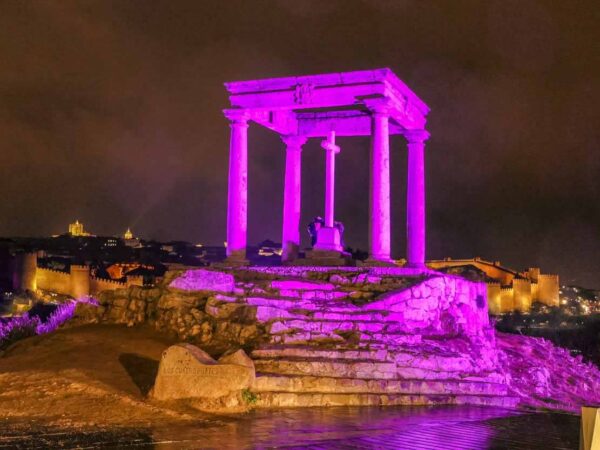
One of the most emblematic corners of Ávila is the humiliation of the Four Posts, a place located on the outskirts of the wall, on the west side of the city.
The word humiliations to the small hermitages that were built at the exits of the city, and the corner now known as the Four Posts corresponds to the humiliation of San Sebastian.
ORGANIZE your TRIP
- Don't forget your TRAVEL INSURANCE with a 5% discount
- Book the HOTEL for your trip
- RENT a CAR for your trip
- The best TOURS and EXCURSIONS in Spanish
- NO-LINE TICKETS for museums and monuments
- Best FREE TOURS around the world
- Book your TRANSFER from the airport
- eSIM card with INTERNET at the best price
Built in 1566 where there is supposedly a small temple in Roman times, it is a complex with four Doric columns in the center of which you can see a granite cross.
This place is currently the best viewpoint of the city of Ávila and great wall at sunset.
Gothic cathedral of Ávila, temple and fortress
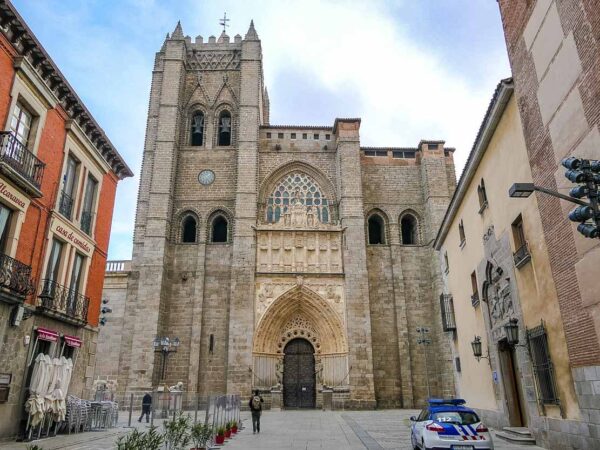
Considered the first gothic cathedral of spain, when you visit Ávila You will be struck by the fact that it is a mixture of temple and fortress, with its apse being a part of the wall.
The current building has its origins in an extension begun in 1172 with a style of transition from Romanesque to Gothic.
The building continued to be built in various phases until the 16th century, and when you visit the interior, you should pay attention to the Traschoro with their Plateresque bas-reliefs, in the Chorus, altarpiece of the High Altar, work of Pedro Berruguete, and the tomb that you can see in the gyro, outstanding work of Spanish Renaissance.
Here you have information with schedules and prices to visit the Cathedral of Ávila.
Polentinos Palace, museum and Military Historical Archive in Ávila

Among the numerous palaces that you can visit in your getaway to Ávila, it is worth highlighting the Polentinos palace, also know as of Contreras.
In the 19th century it happened to house the Quartermaster Academy, and is now the headquarters of Military Historical Archive and a Army Quartermaster Museum.
Inside, the 16th century patio stands out, with its rectangular floor plan surrounded by galleries, with its facades with five columns.
Church and convent of Santa Teresa de Jesús
La visit from Ávila will have as an important protagonist the figure of St. Teresa of Jesus.
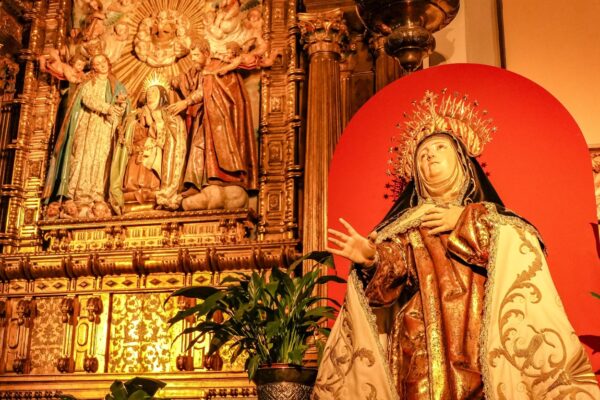
The Saint, as it is known, was born in this city in 1515, and now there are several corners where traces of its presence can be seen.
A key site to visit is the church and convent of Santa Teresa, which was built by the barefoot carmelites in 1636 in the place where his birthplace.
La iglesia It has a Latin cross plan with a central nave and side chapels, and is built in the carmelite baroque.
They highlight their high altar, chapel of Saint Teresa and the large vaulted crypt that now houses a Teresian museum.
Caprotti or Superunda Palace
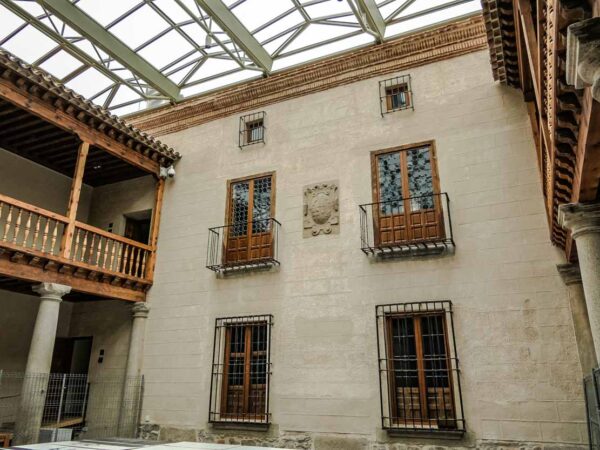
Another notable palace is the one built in Renaissance style in 1580, which in 1916 was acquired by the Italian painter Guido Caprotti.
It will be easy for you to recognize it by its granite façade flanked by two towers.
Inside, its lintel patio which shows great austerity, as well as the exhibition with various pictorial works of the aforementioned Caprotti.
Plaza del Mercado Chico, arcaded plaza with the Ávila City Hall

Located inside the walled enclosure, the Chico Market Square It is the heart of the city since the building of the Town hall.
It is a arcaded square on three of its sides, while on the fourth side only some arches are preserved since it was unfinished as it was located next to the church.
Don't forget your Travel Insurance
Are you organizing your trip or getaway? Don't leave without take out your travel insurance before, and here we explain why. If you hire it with us, you have a 5% discount
This configuration dates back to the reform that took place in the mid-18th century, although the origin of the square dates back to the end of the 11th century.
The current building of Ávila City Council It was built in 1845 and expanded in 1868.
It should be noted that this square hosts a food market on Fridays.
Torreón de los Guzmanes Palace, Renaissance tower in Ávila
S
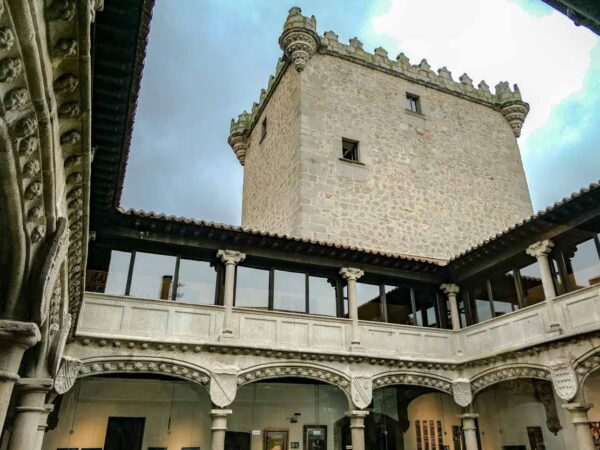
current headquarters of the Provincial Council of ÁvilaThis palace It was built at the beginning of the 16th century, and it will catch your attention for its renaissance tower.
Inside it stands out the porticoed central patio with double gallery and Tuscan Doric columns, as well as the space of the old stables where a has been installed Vetona Culture Interpretation Center.
Basilica of San Vicente, Romanesque church in Ávila
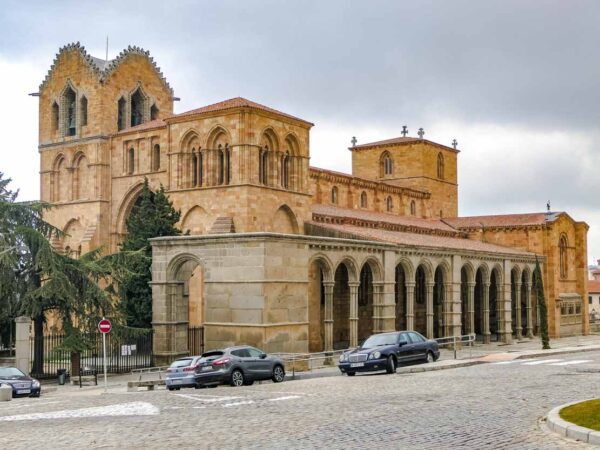
Among the latests Moravia's compositions romanesque churches what can you visit in Ávila, perhaps the most notable is the Basilica of San Vicente.
Located outside the wall, in its northeast corner, it is a building built from 1120, although its porticoed gallery It was not completed until the 15th century.
From its exterior configuration, the orange color of the caleña stone that was used for its construction, although the quarry where it was extracted was exhausted and the building was finished with gray granite stones.
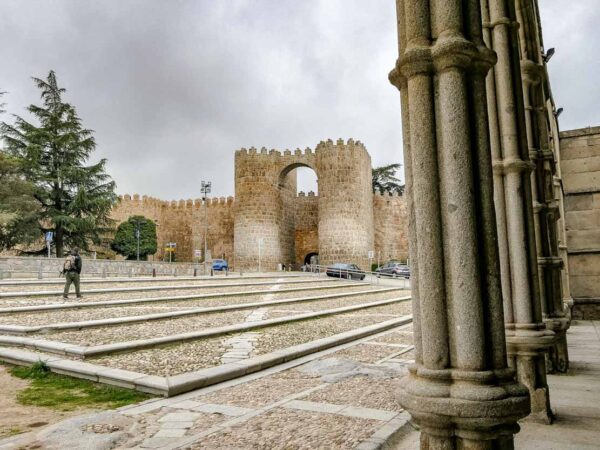
Its interior has a Latin cross plan with three naves, having a gothic clerestory on the side naves.
Also worth highlighting are the historic capitals for the Capilla Mayor.
Here you have information with schedules and prices to visit the Basilica of San Vicente de Ávila.
Palace of the Velada in Ávila

In the cathedral square you can see the Palace of the Veiled which you will recognize by its tower, and which is currently a hotel.
If you go inside you can see the porticoed central patio with three levels, of whose initial configuration only one side is preserved.
Palace of the Executioner in Ávila

Near the St. Vincent's Gate you can see the Palace of the Executioner built at the beginning of the 16th century.
Book your hotel, 15% discount, free cancellation
When planning your trip, we advise you to, well in advance, Book your hotel now on booking.com where you can find discounts from 15% and you will have a possible cancellation for free
It has a plateresque facade, although his greatest interest is in the central courtyard with arches with floral decoration and shields, as well as coffered ceiling on the staircase.
Currently it is the headquarters of the Municipal file and Department of Heritage and Tourism.
Romanesque church of San Pedro and Mercado Grande square
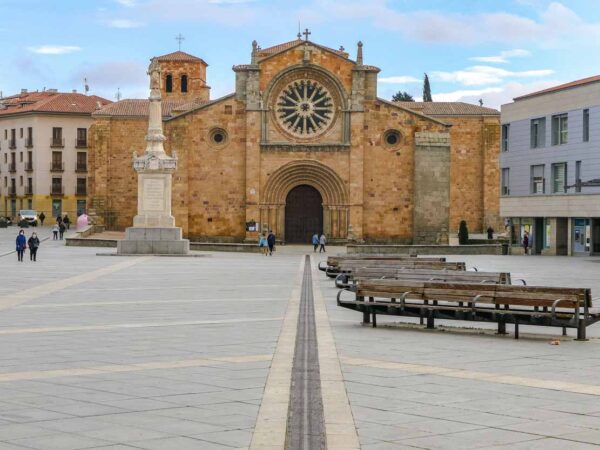
Another of the most outstanding corners of the city of Avila is Big Market Square located outside the walls in the southeast corner of the wall.
In this large square stands out Romanesque church of San Pedro, place where the kings swore to respect the Fueros of Castile.
Completed in the 13th century, the St. Peter's Church It has a Latin cross plan with a triple head, that is, an apse in each nave, where you can see an outstanding sculptural group.
Its main façade will draw your attention greatly to its large rose window.
Palace of Don Juan de Henao, Parador Nacional of Ávila
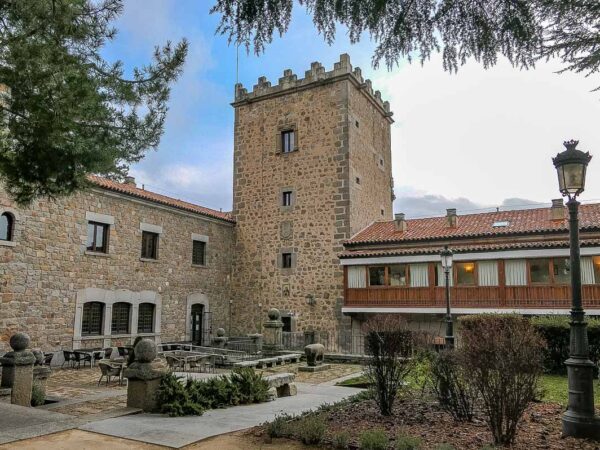
In your Avila city break You can also stay in one of their most notable palaces.
Specifically, in the Palace of Don Juan de Hainaut, which is currently the headquarters of the Parador de Ávila.
It is a building built in the mid-1922th century, which throughout history had various uses, and whose central patio was completely renovated in XNUMX.
Now if you stay in this national hostel you will enjoy the characteristic atmosphere of the palace buildings of Ávila, and it is also worth highlighting the good cuisine of your restaurant.
Reserve your RENTAL CAR now for your trip
Looking ahead to your trip, book your rental car now on this website that offers you the best price guaranteed and allows you a possible free cancellation in most cases. Here you have more information with tips for renting a car
Provincial Museum of Ávila in Santo Tomé el Viejo
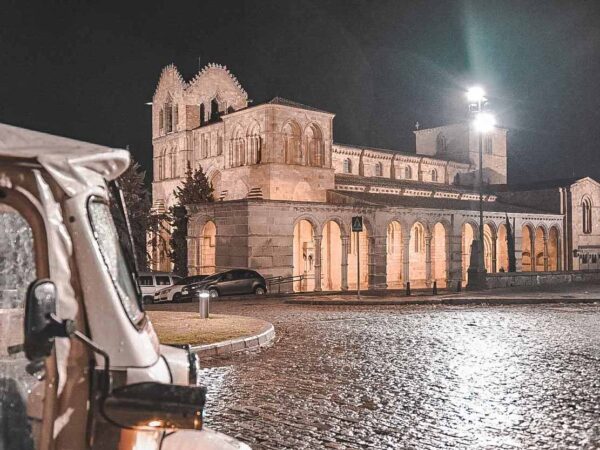
Also outside the wall, specifically, in front of the Flour Weight Gate, you can visit the desecrated building of the old church of Santo Tomé el Viejo, which is now the headquarters of the provincial museum of Ávila.
Here you can sign up for a tuk-tuk tour to visit Ávila with audio guide and a duration of 35 minutes, in which you will get to know the most important corners and monuments of the city
Built in the middle of the 12th century with the aforementioned Cali granite, the eastern and southern portals are preserved from that period.
With a single rectangular nave, after its desecration it has had various uses, and now this museum is a warehouse for various archaeological elements.
Finally, for your visit it will be useful for you to download the pdf with this tourist map of the city of Ávila in which you can see the locations of its main monuments.
Medieval Days in Ávila
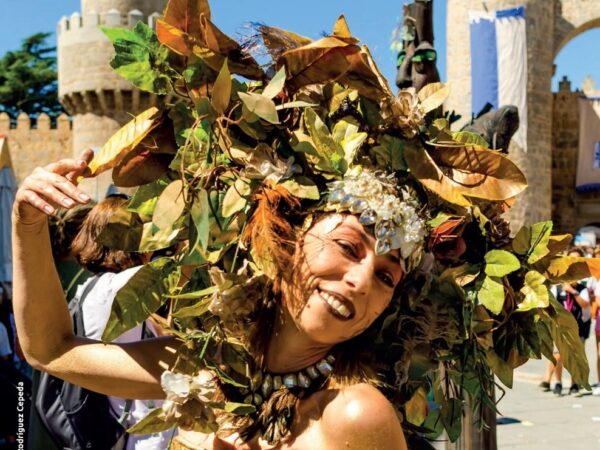
Regarding festive events, without a doubt the celebration of the Medieval Days which take place at the beginning of September are an argument to visit the city.
In 2023 the XXVI edition will be held, whose dates consist of of September 1 to 3, days in which the main streets and squares are surrounded by the typical medieval atmosphere with great parades and tournaments, as well as other shows, gastronomy and music.
They are also known as the “Market of the Three Cultures”, and all kinds of characters give atmosphere to the streets of the city, where you will find Moors, Christians and Jews, minstrels and merchants, bailiffs and silversmiths.


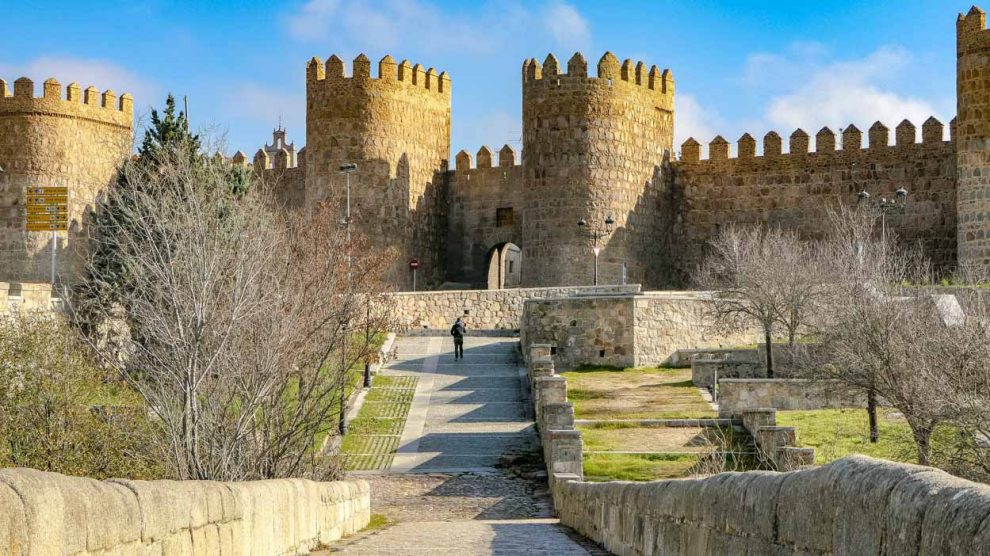

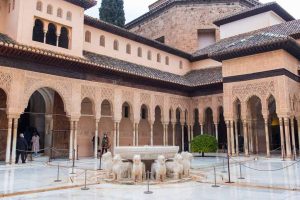
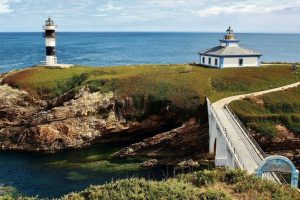











The truth is that every time I have been to the city it is like a trip to the past. Then when you leave the town it is like traveling back in time to your reality. Wonderful !
beautiful place, good walk to enjoy its beauty.